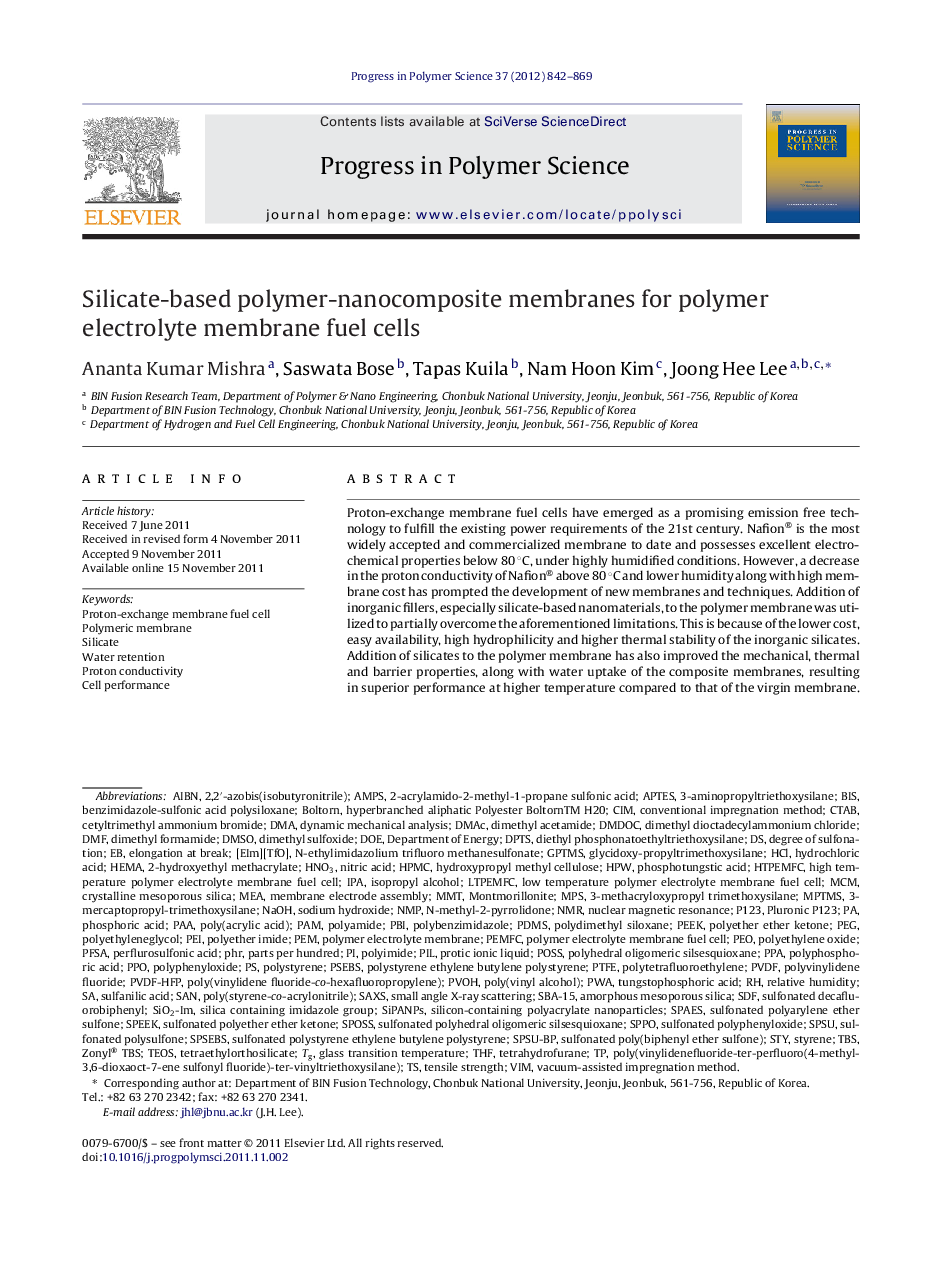| کد مقاله | کد نشریه | سال انتشار | مقاله انگلیسی | نسخه تمام متن |
|---|---|---|---|---|
| 5208605 | 1382590 | 2012 | 28 صفحه PDF | دانلود رایگان |
عنوان انگلیسی مقاله ISI
Silicate-based polymer-nanocomposite membranes for polymer electrolyte membrane fuel cells
دانلود مقاله + سفارش ترجمه
دانلود مقاله ISI انگلیسی
رایگان برای ایرانیان
کلمات کلیدی
PEIDMFHPMCMEATEOSCTABPTFEDOEPDMSPEMFCDMAHClNaOHPVDF-HFPTHFPVDFPEMPAASBA-15PWATBSPAMSDFCIMSTYPPOIPAphrMMTSANPPAPBIMCMAMPsNMPDMAC2-hydroxyethyl methacrylateAIBNHNO3VIMDPTSPOSSN-methyl-2-pyrrolidoneGPTMSHPWSPPOP123Pluronic P1232,2′-azobis(isobutyronitrile)PILPVOHMPTMSSPAESPFSASAXSnuclear magnetic resonance - رزونانس مغناطیسی هستهای3-aminopropyltriethoxysilane - 3-آمینوپروپیلتریتوفاکسیلانDMSO - DMSOsPEEK - speekPolyhedral oligomeric silsesquioxane - sylesquioxane oligomeric polyhedral استTetraethylorthosilicate - tetraethylorthosilicateWater retention - احتباس آبElongation at break - ازدیاد طول در نقطه شکستنStyrene - استایرنTensile strength - استحکام کششیCetyltrimethyl ammonium bromide - استیلتریال آمونیوم برومیدTungstophosphoric acid - اسید تنگستوفسفریکSulfanilic acid - اسید سولفانیلیکPhosphotungstic acid - اسید فسفودوگرامhydrochloric acid - اسید هیدروکلریک یا اسید کلریدریک یا جوهر نمک Polyphosphoric acid - اسید پلی فسفریکPolyethylene oxide - اکسید پلی اتیلنisopropyl alcohol - ایزوپروپیل الکلBIS - بهTetrahydrofurane - تتراهیدروفورانDynamic mechanical analysis - تجزیه و تحلیل مکانیکی پویاNMR - تشدید مغناطیسی هستهای Degree of sulfonation - درجه سولفونیتglass transition temperature - دمای انتقال شیشهdimethyl acetamide - دی متیل استامیدdimethyl formamide - دی متیل فرمامیدDimethyl sulfoxide - دیمتیل سولفواکسیدRelative humidity - رطوبت نسبیPEEK - زیرچشمی نگاه کردنSodium hydroxide, Caustic Soda - سدیم هیدروکسید، کاستیک سودا، سود سوزآورPolymer electrolyte membrane fuel cell - سلول سوختی غشای الکترولیتی پلیمرProton-exchange membrane fuel cell - سلول سوختی غشایی مبدل پروتونhigh temperature polymer electrolyte membrane fuel cell - سلول سوختی پلیمر الکترولیتی درجه حرارت بالا پلیمرsilicate - سیلیکاتcell performance - عملکرد سلولیPolymer electrolyte membrane - غشای الکترولیتی پلیمرPolymeric membrane - غشای پلیمریPhosphoric acid - فسفریک اسیدProtic ionic liquid - مایکروویو غلیظAPTES - مناسبMontmorillonite - مونت موریلونیتmembrane electrode assembly - مونتاژ الکترود غشاییMPs - نمایندگان مجلسNitric acid - نیتریک اسید، اسید نیتریک proton conductivity - هدایت پروتونHEMA - هماHydroxypropyl methyl cellulose - هیدروکسی پروپیل متیل سلولزDepartment of Energy - وزارت انرژیsmall angle X-ray Scattering - پراکندگی اشعه ایکس زاویه کوچکPoly(styrene-co-acrylonitrile) - پلی (استایرن اکریلنیتیل)Polyamide - پلی آمیدpolyether ether ketone - پلی اتر اتر کتونpolyethyleneglycol - پلی اتیلن گلیکولpoly(acrylic acid) - پلی اکریلیک اسیدPolyimide - پلی ایمیدPolybenzimidazole - پلی بنزیمیدازولpolytetrafluoroethylene - پلی تترافلورو اتیلنSulfonated polysulfone - پلی سولفون سولفون شدهPoly(vinyl alcohol) - پلی وینیل الکل)Poly(vinylidene fluoride-co-hexafluoropropylene) - پلی وینیلیدین فلوئورید co-hexafluoropropylenePolyvinylidene fluoride - پلی وینیلیدین فلورایدpolydimethyl siloxane - پلییدیدیل سیلوکسانPEG - پلیاتیلن گلیکول Polystyrene - پلیاستایرن PEO - پیوSulfonated polyether ether ketone - کتون پلی استر اتر سولفون شده
موضوعات مرتبط
مهندسی و علوم پایه
شیمی
شیمی آلی
پیش نمایش صفحه اول مقاله

چکیده انگلیسی
Proton-exchange membrane fuel cells have emerged as a promising emission free technology to fulfill the existing power requirements of the 21st century. Nafion® is the most widely accepted and commercialized membrane to date and possesses excellent electrochemical properties below 80 °C, under highly humidified conditions. However, a decrease in the proton conductivity of Nafion® above 80 °C and lower humidity along with high membrane cost has prompted the development of new membranes and techniques. Addition of inorganic fillers, especially silicate-based nanomaterials, to the polymer membrane was utilized to partially overcome the aforementioned limitations. This is because of the lower cost, easy availability, high hydrophilicity and higher thermal stability of the inorganic silicates. Addition of silicates to the polymer membrane has also improved the mechanical, thermal and barrier properties, along with water uptake of the composite membranes, resulting in superior performance at higher temperature compared to that of the virgin membrane. However, the degrees of dispersion and interaction between the organic polymer and inorganic silicates play vital roles in improving the key properties of the membranes. Hence, different techniques and solvent media were used to improve the degrees of nanofiller dispersion and the physico-chemical properties of the membranes. This review focuses mainly on the techniques of silicate-based nanocomposite fabrication and the resulting impact on the membrane properties.
ناشر
Database: Elsevier - ScienceDirect (ساینس دایرکت)
Journal: Progress in Polymer Science - Volume 37, Issue 6, June 2012, Pages 842-869
Journal: Progress in Polymer Science - Volume 37, Issue 6, June 2012, Pages 842-869
نویسندگان
Ananta Kumar Mishra, Saswata Bose, Tapas Kuila, Nam Hoon Kim, Joong Hee Lee,